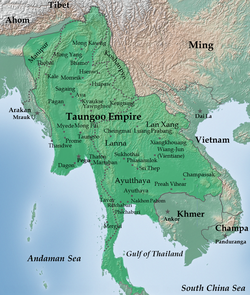Lê dynasty
| Later Lê Dynasty | ||||||||||||||||
| Nhà Hậu Lê | ||||||||||||||||
|
||||||||||||||||
|
Vietnam in 1760 under the Later Lê dynasty
|
||||||||||||||||
| Capital | Đông Kinh | |||||||||||||||
| Languages | Vietnamese | |||||||||||||||
| Religion | Neo-Confucianism, Buddhism, Taoism | |||||||||||||||
| Government | Monarchy | |||||||||||||||
| Emperor | ||||||||||||||||
| • | 1428–1433 | Lê Lợi (first) | ||||||||||||||
| • | 1786–1789 | Lê Chiêu Thống (last) | ||||||||||||||
| History | ||||||||||||||||
| • | Coronation of Lê Lợi | 15 March 1428 | ||||||||||||||
| • | Mạc Đăng Dung usurped the throne | 15 June 1527 | ||||||||||||||
| • | Kỷ Dậu Victory | January 1789 | ||||||||||||||
| Currency | Văn (Sapèque) | |||||||||||||||
|
||||||||||||||||
| Today part of |
|
|||||||||||||||
The Later Lê dynasty (Vietnamese: Nhà Hậu Lê; Hán Việt: 後黎朝), sometimes referred to as the Lê dynasty (the earlier Lê dynasty ruled only for a brief period (980–1009)), was the longest-ruling dynasty of Vietnam, ruling the country from 1428 to 1788, with a brief six-year interruption of the Mạc dynasty usurpers (1527-1533). Vietnamese historians usually distinguish the 100-year Later Lê dynasty early period (1428 to 1527) from 256-years of figurehead emperors of the Later Lê dynasty warlord period (1533 to 1789) following the dynasty's restoration by powerful warlords.
The dynasty officially began in 1428 with the coronation of Lê Lợi after he drove the Ming army from Vietnam. In 1527, the Mạc dynasty usurped the throne; when the Lê dynasty was restored in 1533, they still had to compete for power with the Mạc dynasty during the period known as Southern and Northern Dynasties. The restored Lê emperors held no real power, and by the time the Mạc dynasty was confined to only a small area in 1592 and finally eradicated in 1677, actual power was in the hands of the Nguyễn lords in the South and the Trịnh lords in the North, both ruling in the name of the Lê emperor while fighting each other. Their rule officially ended in 1788, when the peasant uprising of the Tây Sơn brothers defeated both the Trịnh and the Nguyễn, ironically in order to restore power to the Lê dynasty.
The Lê dynasty's rule saw Vietnam's territories grow from a small state in northern Vietnam at the time of Lê Lợi's coronation into almost its current size by the time the Tây Sơn brothers took over. It also saw massive changes to Vietnamese society: the previously Buddhist state became Confucian after 20 years of Ming rule. The Lê emperors instituted many changes modeled after the Chinese system, including the civil service and laws. Their long-lasting rule was attributed to the popularity of the early emperors. Lê Lợi's liberation of the country from 20 years of Ming rule and Lê Thánh Tông's bringing the country into a golden age was well-remembered by the people. Even when restored Lê emperors' rule was marked by civil strife and constant peasant uprisings, few dared to openly challenge their power, at least in name, for fear of losing popular support. When the Mạc dynasty tried to do so, they were not successful and were considered as usurpers and not recorded in official histories by later dynasties.
...
Wikipedia

